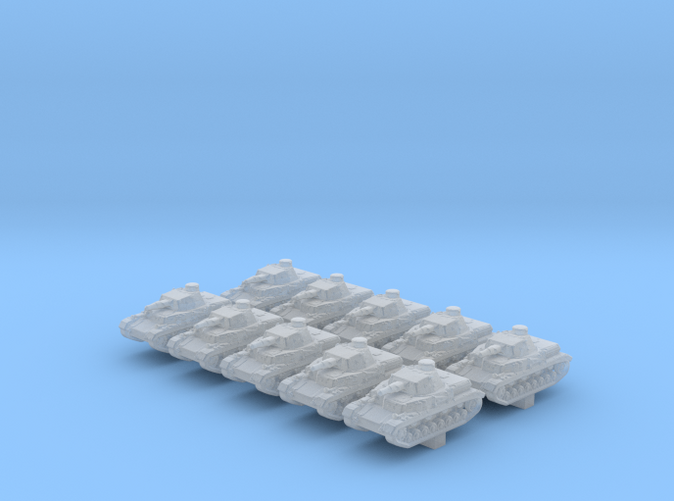1/600 Scale WW2 German Army Pz.Kpfw. IV Ausf. A Medium Tank.
Contains 10 highly detailed tanks.
Contains:- 10x Pz.Kpfw. IV Ausf. A Medium Tanks
Pz.Kpfw. IV Ausf. A Medium Tank
The
Panzerkampfwagen IV (
PzKpfw IV), commonly known as the
Panzer IV, was a
German medium tank developed in the late 1930s and used extensively during the
Second World War. Its ordnance inventory designation was
Sd.Kfz. 161.
The Panzer IV was the most widely manufactured
German tank of the Second World War, with some 8,500 built. The Panzer IV was used as the base for many other fighting vehicles, including the
Sturmgeschütz IV assault gun,
Jagdpanzer IV tank destroyer, the
Wirbelwind self-propelled anti-aircraft gun, and the
Brummbär self-propelled gun.
The Panzer IV saw service in all combat theaters involving Germany and was the only German tank to remain in continuous production throughout the war. Upgrades and design modifications, intended to counter new threats, extended its service life. Generally, these involved increasing the Panzer IV's
armor protection or upgrading its weapons, although during the last months of the war, with Germany's pressing need for rapid replacement of losses, design changes also included simplifications to speed up the manufacturing process.
The Panzer IV was partially succeeded by the
Panther medium tank, which was introduced to counter the Soviet
T-34, although the Panzer IV continued as a significant component of German armoured formations to the end of the war. The Panzer IV was the most widely exported tank in German service, with around 300 sold to Finland, Romania, Spain and Bulgaria. After the war, Syria procured Panzer IVs from France and Czechoslovakia, which saw combat in the 1967
Six-Day War. 8,553 Panzer IVs of all versions were built during World War II, with only the
StuG III assault-gun/tank destroyer's 10,086 vehicle production run exceeding the Panzer IV's total among Axis armored forces.
The first mass-produced version of the Panzer IV was the
Ausführung A (abbreviated to Ausf. A, meaning "Variant A"), in 1936. It was powered by
Maybach's HL 108TR, producing 250 PS (183.87 kW), and used the SGR 75 transmission with five forward gears and one reverse, achieving a maximum road speed of 31 kilometres per hour (19.26 mph). As main armament, the vehicle mounted the short-barreled,
howitzer-like 75 mm (2.95 in)
Kampfwagenkanone 37
L/24 (7.5 cm KwK 37 L/24) tank gun, which was a low-velocity weapon mainly designed to fire high-explosive shells. Against armored targets, firing the
Panzergranate (
armor-piercing shell) at 430 metres per second (1,410 ft/s) the KwK 37 could penetrate 43 millimetres (1.69 in), inclined at 30 degrees, at ranges of up to 700 metres (2,300 ft). A 7.92 mm (0.31 in)
MG 34 machine gun was mounted
coaxially with the main weapon in the turret, while a second machine gun of the same type was mounted in the front plate of the hull. The main weapon and coaxial machine gun were sighted with a Turmzielfernrohr 5b optic while the hull machine gun was sighted with a Kugelzielfernrohr 2 optic. The Ausf. A was protected by 14.5 mm (0.57 in) of steel armor on the front plate of the chassis, and 20 mm (0.79 in) on the turret. This was only capable of stopping
artillery fragments,
small-arms fire, and light anti-tank projectiles.
Cleaning Information
Some part cleanup will be necessary. The 3D printing process uses a waxy substance to support certain part features during the printing process. Although the parts are cleaned by Shapeways, some waxy residue may remain. It can be safely removed with water and a mild aqueous detergent like "Simple Green" using an old, soft toothbrush, Q-tips or pipe cleaners. During the printing process, liquid resin is cured by ultraviolet light. Microscopic bits of resin may remain uncured.
Let your parts sit in direct sunlight for a few hours to fully cure the resin.
Water-based acrylic paints meant for plastics is strongly recommended. Other paints, especially enamels, may not cure on Frosted Detail 3D-printed plastics.
Use dedicated model sprue cutters to remove parts to minimise the risk of damage to parts.
Please take a look at my other items.
Painting tips and preparation
